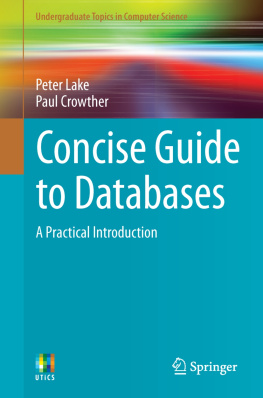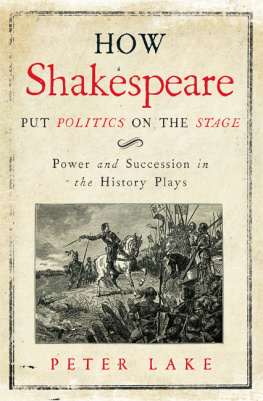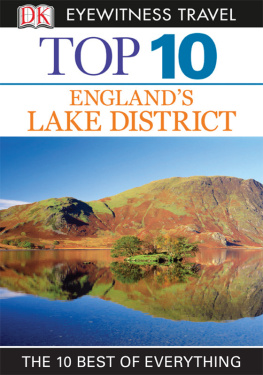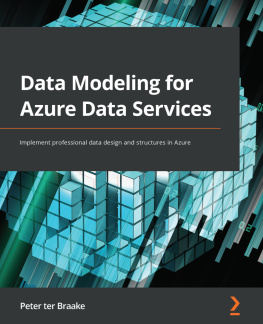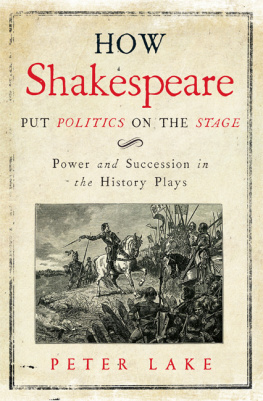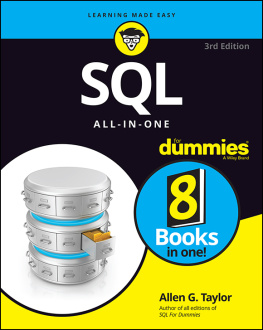Peter Lake and Paul Crowther Undergraduate Topics in Computer Science Concise Guide to Databases 2013 A Practical Introduction 10.1007/978-1-4471-5601-7_1
Springer-Verlag London 2013
1. Data, an Organisational Asset
Abstract
Data has always been at the centre of an organisations operations and decision making. Today an organisation depends on data for its very survival. Data is used to make strategic decisions about the future direction an organisation will take and for that the data must be both current and accurate. Because data is an asset to a company it can be given a value and it can be traded. This chapter will look at data as an organisational asset tracing its importance in recording, analysing and planning as organisations grew and became more sophisticated. The impact of industrialisation on data requirements will be examined and finally with the advent of electronic data storage and processing, the emergence of data as an important component of a companys assets. Finally there will be a discussion of big data and the current issues surrounding privacy when everything that can be recorded is recorded.
What the reader will learn:
The rise of the organisation
The evolution of data usage and processing in organisations
Technological change and its impact on data
Data storage, retrieval and analysisthe road to competitive advantage
Data exploitation and privacy
1.1 Introduction
Today an organisation depends on data for its very survival. Data is used to make strategic decisions about the future direction an organisation will take and for that the data must be both current and accurate. Because data is an asset to a company it can be given a value and it can be traded. This chapter will look at data as an organisational asset tracing its importance in recording, analysing and planning as organisations grew and became more sophisticated. The impact of industrialisation on data requirements will be examined and finally with the advent of electronic data storage and processing, the emergence of data as an important component of a companys assets. Finally there will be a discussion of big data the current issues surrounding privacy when everything that can be recorded is recorded.
There are many examples of data being an organisational asset, but we will start with a specific well known example. Amazon, is an on-line retailer which originally sold books. It has now become an organisation dealing with a large variety of goods and services both as the primary seller and as a facilitator for other retailers. Any web user can search for items using key words and can restrict their search in various ways. Once you buy an item from Amazon you can create an account. Amazon uses the information about what you bought (and searched for) to suggest other items you might like to buy. It also cross references this with what other people bought. So if you bought a wireless networking card for your desktop computer, you would also get a list of what other people bought with it. Google is exploiting data in your transaction in real time to influence your shopping decisions.
This is an example of how an organisation uses data in an on-line transaction in a real time way. It is the current stage of an evolutionary process of storing, processing and exploiting data which began with the first record keeping.
1.2 In the Beginning
Religious orders and governments were the first large organisations to gather and actively exploit data to raise revenue. Recorded data has been known to exist since at least 2800 BC in ancient Egypt. These included records of the earliest known forms of taxation. Records were held on limestone flakes and papyrus. The Rosetta Stone, famous for holding the key to translating hieroglyphics (the same information was written in three languages on the stone, one of which could be understood and was used to translate the other two) was created to show a temples exemption from taxes.
1.3 The Rise of Organisations
Before considering electronic data and its use in modern commercial organisations we need to consider how non-government organisations developed and how their data needs grew more and more sophisticated. In any government or business organisation, there are always records. At its most basic you need to know who owes you money and who you owe money to. More sophisticated records would include the value of infrastructure such as buildings and machinery as well as its depreciationloss of valuedue to wear and tear plus the costs of maintenance. Where the organisation consists of more than a single trader records of employees need to be kept.
In Britain pre-dissolution monasteries maintained excellent records and accounts of the estates they controlled (something that was also of value to Henry VIII and which Thomas Cromwell exploited from 1534 as part of the Dissolution). Lands and money were donated to the monasteries with many of them becoming large landowners. Income from these estates made many of them extremely wealthy. This growth in wealth along with numbers of lay brothers who filled ancillary roles and provided labour created a complexity that could only be managed by keeping records. The monk in charge of these records and the finances of the monastery was the bursar who oversaw the maintenance of detailed records of both income and expenditure of the estate. In many cases this was structured within specific categories, for example capital expenditure (on buildings). In todays terminology the bursar would be called the database administrator.
1.4 The Challenges of Multi-site Operation
The monasteries in sixteenth century England were independent organisations loosely federated by their allegiance to the Roman Catholic Church based in Rome. As mentioned, they often owned vast estates with many farms or granges which could be considerable distances (for the day) from the monastery. These granges needed to keep local records, but also needed to submit accounts to the monastery. This could be regarded as a form of distributed data where there was a need for day to day local account keeping along with a centralised master account system. A problem was maintaining data integrity. Once accounts from the granges had been submitted to the monastery counting house, records could be updated but there was always a time delay. At the time this was not regarded as important because at the time there was no competitive advantage in very rapid processing of records.
1.5 Internationalisation
Despite the previous example most early organisational data was held centrally because the reach of the organisation tended to be geographically small. This changed with exploration and colonisation. There needed to be data kept in multiple locations. With European colonisation of other parts of the world, trading companies had to start keeping data locally as well as at head office. Some of these companies were huge, for example the East India Company came into being in 1600 and by the eighteenth century effectively controlled large parts of India and had its own army and navy. Its base was London, but it had multiple trading centres in India and China. The London base was called East India House and it housed the company records. These and the people needed to maintain them kept growing with the result that the building was continually being expanded. The demand for more space and the poor condition of the original building lead was the justification for a new building. This was completed in 1729. Even this was not enough and as the company continued to grow adjoining properties were acquired.

